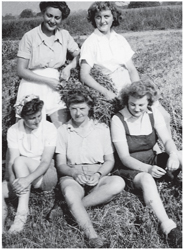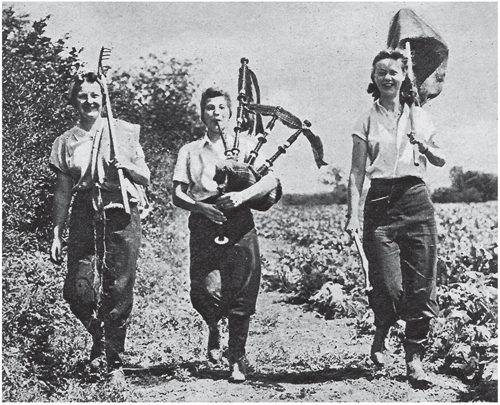Essex Land Girls (9 page)
Authors: Dee Gordon


Eva Parratt née Funnell (front row, left) and unidentified chums. (Courtesy of Rosemary Pepper)
Others, like
Dorothea Strange
from Hockley, would stay at home when they could, dependent on the farm they had been allocated. In her case, she also ‘used billets at Broxted and Stansted’.
Iris Richardson
had a few opportunities to live at home when working in Essex, but also worked on ‘much bigger farms in Buckinghamshire’ where she stayed in a hostel, travelling there on her ‘first ever train journey’ in 1942. As for
Margaret Penfold
, she was ‘billeted a long way out [in Halstead], one place an old Victorian house and another a hostel built for Italian prisoners of war but taken over by the WLA …’ but at one point, when working on a ‘farm in Chigwell Row, nearer home in Ilford’, she would travel home. Working on a ‘farm in Boreham’ though, meant another move, to Chelmsford, and she ‘was issued with a heavy bike’ for the daily journey.
Diana Thake was a trainee hairdresser in Loughton when she volunteered to join the WLA. She was sent to Woodredon Farm at Waltham Abbey, where pedigree Ayrshires were bred. In the September/October 2005
Loughton & District Historical Society Newsletter
, she had this to say: ‘I was really lucky … It was around four miles away from where I lived and I used to cycle there and back every day.’
Because
Babs Newman
joined in 1943, she was sent straight from her home in Lexden to a hostel. This was in Takeley, near Stansted, where she ‘lived with twelve cockney girls’.
Betty Cloughton
‘was billeted with a family [in West Mersea] who remained good friends for many years. From there, I was sent to a hostel in Wickham Bishops, then into a private billet in the same village with a couple who were so nice and treated me like a daughter then and for many years.’
Edna Green
stayed in the farmhouse attached to Graveleys Farm at Great Waltham, run by:
… a loving couple [who] took me to their hearts straight away. They were a devoted couple, hardworking and caring people, and I grew to love them dearly. In the evening we would sit by the light of the oil lamp, and talk about our hard day’s work and … later, after a warm cup of cocoa, but never ever later than nine o’clock, a candle lit my way up the old oak stairs to my cosy room.
A later billet, however, ‘shared with 40 girls’, offered ‘atrocious food’ and, even worse, when it was being decorated they were ‘moved to an original doctor’s surgery, complete with a skeleton in a cupboard’ which came as quite a surprise …
Another account of the WLA hostel experience was given by
Rene Wilkinson
. She lived with ‘forty girls in a hostel in Station Road, Stansted, [with] Mrs Dover, a dragon, in charge’. Facilities here included ‘a pot-bellied stove, an ablution block, dormitories with four bunks in each bay, a dining hall and kitchen. After an alarm call at 7 a.m., cereal [was provided] for breakfast [and we] collected lunch … four slices … with a cooked meal at night.’
Winnie Bell
was billeted in Ingatestone High Street to start with, along with three other Land Girls, but was also able to travel home every night when working at Rainham. She remembers one billet ‘in a village with a tractor driver and his wife’, and a hostel near Margaretting, ‘now a listed building’, where she ‘shared a bed’ with her friend. Sharing a bed was not at all unusual and readily accepted. East Ender
Florence Rawlings
recalls being billeted at one time with the Barker family close to Ramsden Bellhouse, and ‘sharing a bed with their eight year old daughter … an uncomfortable bed with a flock pillow’.
Rather different accommodation was provided for several members of the Dagenham Girl Pipers. They camped in chalets in the garden of a thatched cottage owned by Reverend Graves (the founder and manager of the band) at Great Sampford. There is a mention of three pipers ‘working the land’ in the
Dagenham Post
,
dated 12 July 1940, referring to a farm near Saffron Walden.
Irene Verlander
wrote of a billet in Boxted which was a pretty country cottage, but with ‘damp beds, and the cook often missing because she was always at Boxted Airfield [near Langham] with the American pilots’! When she and her friend complained to the local secretary, Mrs Solly-Flood, they had to travel to Witham to explain the situation and were told off for their lack of forbearance, but Irene was given work nearer her home, so it had been worth making a fuss.

Left to right: Grace Richards, Margaret Fraser and Ada Clatworthy. Dagenham Girl Pipers working the land. (Courtesy of Linda Rhodes)
Many girls – including a large contingent from Romford – were billeted in Orleans, on Mersea, a big old house now long gone. They were taken to their place of work by Underwood’s coal lorry, not the best or cleanest form of travel!
A different viewpoint was offered by
Winifred Daines
from Plaistow. She felt that the WLA ‘opened hostels just to save money’, but ‘the landladies had prepared their homes to take in Land Girls, and needed the money’. As a result, she ‘invented a special diet, and was allowed to continue to stay in billets’ which were mainly around Braintree and Grays. A lady of principles!
HE
H
OSTEL
E
XPERIENCE
There is no published list of WLA hostels in Essex. The following list may not be complete, and is reliant on press references and the memories of those that were there, with memory being a capricious animal. However, it gives some idea of the spread of hostels across the county:
•
Wigborough Road, Peldon, Colchester
•
The Avenue, Colchester
•
Lexden Road, Colchester (Colchester had its own WLA organiser because of the numbers billeted in the town – around 150)
•
Nazeing
•
Layer Marney
•
Fordham
•
Creeksea Hall, Burnham-on-Crouch
•
Totham, near Maldon
•
Rettendon
•
Halstead, Bluebridge Hill
•
Garth End, Little Braxted
•
Mark Hall, Harlow
•
Cranham
•
Thundersley
•
Coggeshall House
•
Orleans, Mersea
•
Great Totham
•
Wickham Bishops
•
Broxted
•
Station Road, Stansted
•
The Limes, Takeley
•
Great Codham Hall, near Braintree
•
Thoby Hall, Mountnessing
•
Butlers Hostel, Broomfield
•
Langley
•
Margaretting
•
Great Dunmow (possibly two here)
•
Warley
•
Park House, Bradwell
•
Mangapp’s, near Burnham on Crouch
•
Stambridge
•
Rochford
The wardens or supervisors employed to take charge of these hostels and the Land Girls were a diverse range of women and did not always stay the distance. Joanna Round, for instance, was the supervisor at Peldon in 1942, having previously been in the EWAG office at Colchester, but left in July 1943 to be replaced by ‘Mrs V.’ who was given notice to leave soon after. This apparently put her in quite a rage, according to E.J. Rudsdale’s
Journals of Wartime Colchester
, but as she had a reputation for doing more harm than good, she was perhaps not a great loss.
When the hostel at Langley opened in 1943 (the nearest hostel prior to this for Land Girls in north Essex was over the Hertfordshire border at Brent Pelham) it took some time to find a warden because of the remoteness of the village. The vicar called upon his wife Doris, an ex-teacher, to act as a live-in warden until a permanent one could be found, and she moved in with their 5-year-old daughter plus a cook to help out. Jacqueline Cooper (in
Clavering at War
) quotes the vicar as announcing:
It is a return to bachelor days, but I shall do that gladly knowing that the national effort is being helped on in a small way by my household. I am sure that in both Langley and Clavering a welcome will be given to these girls, most of whom are new recruits from London and quite unused to life as we know it in a small village.
Doris did a grand job, by all accounts, for the few weeks until her replacement arrived and by September 1943 there were twenty girls in residence.
The Essex WLA were still recruiting staff for local hostels in February 1944. There was an advertisement in the
Chelmsford Chronicle
(4 February) pointing out an ‘urgent’ need for ‘cooks and domestics’ offering ‘good pay and outings’. Applications were being dealt with by the organising secretary of the WLA at the Essex Institute of Agriculture, Writtle. The wardens were effectively advised by the county offices of the WLA to make the hostel the centre of the social life of the neighbourhood, and to include billeted Land Girls and local residents in hostel activities whether these were mainly dances or such down-to-earth pastimes as make-and-mend classes or lectures.
In October 1944, ‘K. Brenner’ from ‘The Limes, Takeley’, wrote to
The Land Girl.
She announced the introduction of a hostel news-sheet with contributions from members of the hostel in the form of poems and experiences, with the addition of local newspaper cuttings. The writer’s idea was to produce something that ‘everyone had a hand in’ to make them ‘feel closer in spirit as well as in achievement’.
Once male labour was at a minimum (
c.
1941) the Land Girls were gradually accepted, though at first many farmers were dubious. Farm worker Victor Sibley remembers five Land Army Girls arriving on his Halstead farm who had ‘never seen a pitchfork or even a mouse …’ and took three to four weeks to learn how to use basic implements. He described some of them as having had ‘butlers waiting on them at home’ so were now leading a very different life, based in the hostel nearby and cycling to the farm. He was not unsympathetic to their working conditions, however, especially the lack of toilet facilities in a 20-acre field where only ‘dock leaves were available as toilet paper’.
The
Essex Chronicle
of 11 July 1941 described the Land Girls as ‘excellent workers’ with particular reference to those ‘specialising in market gardening and poultry work’ and praised them for working in conditions which meant some of them sleeping in ‘converted poultry houses’.
In January 1943, however, the
Essex Chronicle
was still pointing out the lack of training for too many Land Girls. The annual meeting of the Waltham Abbey branch of the National Farmers’ Union passed a resolution to ‘make representations to the proper authority to ensure that Land Girls receive some training before being posted to farms’. Mr Willis Chapman complained of ‘absolutely green girls being dumped on the farms … the authorities would not dump an untrained A.T.S. on a searchlight site’, he said. At least one member was fighting the WLA’s corner, however, with Mr Walker, the county secretary, reminding members that ‘the training ground for them is the farm’.
This was around the same time that the local War Ag committee staged Land Army exhibitions at the Corn Exchanges in Saffron Walden, Braintree, Chelmsford, and Colchester, described in
The Land Girl
of February 1943. The exhibitions, aimed at ‘sceptical’ farmers who were unaware of what a ‘mere girl’ could do, included photographs of volunteers at work and a model farm with thirteen volunteers giving demonstrations, evoking ‘heartening’ interest. Two months later, the
Essex Newsman
reported a meeting of the Southminster Farmers’ Union, whose president announced that Land Girls were ‘tackling their work in a splendid way and doing yeoman service … on the whole they were taking on men’s jobs and doing them thoroughly’.
